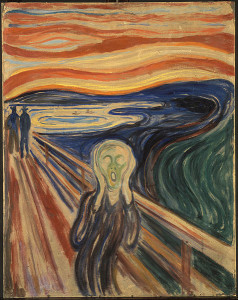in shade of tall green grasses,
duck laughs from corner.
 The sun was going down—had
The sun was going down—hadA baby medusa
| This is a baby medusa. The diameter is about 1mm. Because of the long distance from Miyakawa's home (over 250km), this baby medusa was not alive when received. The tentacles were missing and no movements were observed. Next morning this tiny medusa had disappeared in the bottle.Miyakawa feeds them brine shrimps (the salt must be removed), but he thinks some rotifers are better food for babies. |
How polyps feed
| As you know, the medusa is only one stage of the life cycle of jellyfish. They stick on substrates and live as polyps before they become medusae. The lefthand picture shows the ceramic tips on which the polyps were attached. I can't find the polyps with the naked eye. |
I think the word "polyps" remind you of Hydra. But these polyps don't look like them. The size is much smaller and no clear tentacles exist.However, like the Hydra they are also a carnivorous animal. They catch prey by nematocysts and swallow them. The next three pictures show this process.
